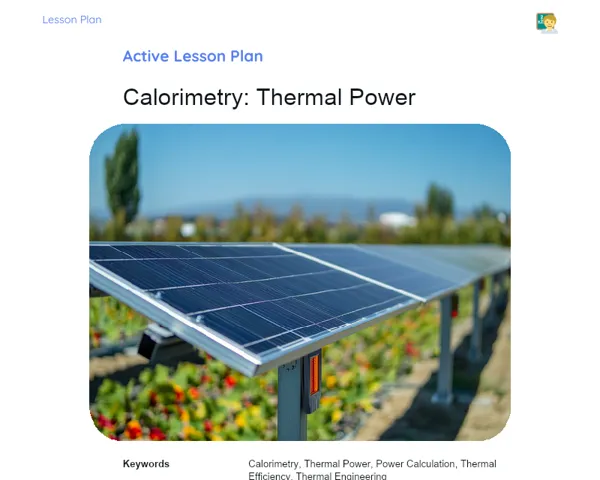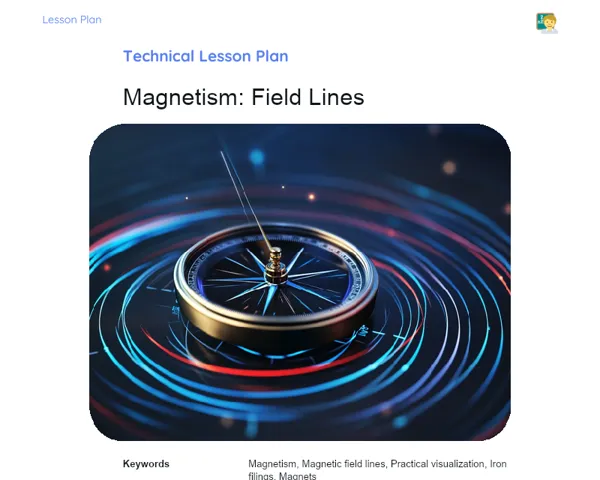Lesson Plan | Lesson Plan Tradisional | Calorimetry: Thermometer Scale Changes
| Keywords | Calorimetry, Thermometric Scales, Celsius, Fahrenheit, Kelvin, Temperature Conversion, Temperature Measurement, Practical Problems, Contextualization, Curiosities, Problem Solving, Practical Applications, Daily Relevance |
| Resources | Whiteboard, Markers, Projector, Presentation Slides, Calculators, Printed Copies of Exercises, Thermometers of Various Scales (optional), Physics Textbook, Notepads for Each Student, Pencils or Pens |
Objectives
Duration: (10 - 15 minutes)
This segment aims to provide a clear foundation for the lesson, ensuring students understand what is expected of them. By laying out the main objectives, the teacher can streamline the lesson to focus on core skills, facilitating the learning process, and ensuring that all essential topics are covered in an orderly and understandable manner.
Objectives Utama:
1. Understand that the temperature of two bodies can be measured.
2. Learn how to gauge the temperature of an object.
3. Convert the temperature of an object between the main scales (Celsius, Kelvin, and Fahrenheit) and to other scales.
Introduction
Duration: (10 - 15 minutes)
The aim of this phase is to ignite students' curiosity about the subject and link it to practical, relatable experiences. By setting a context and sharing intriguing facts related to the topic, the teacher can grab students' attention and prepare them to grasp the concepts that will be discussed in the lesson.
Did you know?
Did you know that the Celsius scale was established by Swedish astronomer Anders Celsius in 1742? Interestingly, the scale was originally inverted, where 100°C indicated the boiling point of water, and 0°C marked the freezing point. It was only after Celsius's passing that it was reversed to the form we recognize today. Moreover, the Kelvin scale, commonly used in scientific research, starts at absolute zero, a hypothetical temperature where particles are thought to be at complete rest.
Contextualization
To begin the discussion on Calorimetry: Changes of Thermometer Scales, it's important to connect students with the significance of temperature measurement in various fields of science and day-to-day life. Emphasize that temperature is a physical measure reflecting the degree of motion of particles in an object. Precise temperature measurement is crucial in fields such as meteorology, healthcare, cooking, engineering, and even daily experiences, like checking the weather advisory or assessing a person’s fever.
Concepts
Duration: (40 - 50 minutes)
This segment aims to deepen students' understanding of thermometric scales and how to convert between them effectively. By tackling fundamental topics, illustrating practical examples, and solving problems in a structured way, the teacher ensures that students not only grasp the conversion formulas but also comprehend their practical applications. This fosters a more enriched and meaningful learning experience.
Relevant Topics
1. Thermometric Scales: Discuss the primary thermometric scales (Celsius, Fahrenheit, and Kelvin). Elaborate on their history and practical use, highlighting their significance in different fields and daily situations.
2. Conversion Between Scales: Outline the formulas required for converting between temperature scales. For instance, the formula for converting Celsius to Fahrenheit (F = (C * 9/5) + 32), Celsius to Kelvin (K = C + 273.15), and vice versa. Clarify the rationale behind these formulas.
3. Practical Examples: Present realistic scenarios for temperature conversion. Demonstrate how to convert an object's temperature from one scale to another. Use relatable situations, like weather updates or measuring body temperature, to make the content more accessible.
4. Problem Solving: Guide students through problem-solving exercises. Introduce typical temperature conversion scenarios and analyze them step by step, elucidating each stage of the process.
To Reinforce Learning
1. What is the temperature in Fahrenheit if a body is at 25°C?
2. Convert 300K to the Celsius scale.
3. If the temperature of a body is 98.6°F, what is this temperature in Celsius?
Feedback
Duration: (20 - 25 minutes)
The focus of this phase is to review and reinforce the learning achieved by students, ensuring they have a firm understanding of temperature conversions. By discussing the questions posed and engaging students in reflective discussions, the teacher can identify any uncertainties and clarify key concepts within the content.
Diskusi Concepts
1. Question 1: What is the temperature in Fahrenheit if a body is at 25°C? 2. Explanation: 3. To convert the temperature from Celsius to Fahrenheit, we apply the formula F = (C * 9/5) + 32. 4. Substituting the values: F = (25 * 9/5) + 32 = 77°F. 5. Question 2: Convert 300K to the Celsius scale. 6. Explanation: 7. To convert from Kelvin to Celsius, we use the formula C = K - 273.15. 8. Substituting the values: C = 300 - 273.15 = 26.85°C. 9. Question 3: If the temperature of a body is 98.6°F, what is this temperature in Celsius? 10. Explanation: 11. To convert from Fahrenheit to Celsius, we utilize the formula C = (F - 32) * 5/9. 12. Substituting the values: C = (98.6 - 32) * 5/9 = 37°C.
Engaging Students
1. 📌 Questions for student discussion: 2. Why is it crucial to understand how to convert between different temperature scales? 3. How can accuracy in temperature measurement affect fields like healthcare and meteorology? 4. What are some everyday scenarios where temperature conversion is particularly beneficial? 5. Can anyone share an instance when temperature measurement played an important role?
Conclusion
Duration: (10 - 15 minutes)
The aim of this stage is to encapsulate and solidify the main points discussed during the lesson, reinforcing students' understanding. It also seeks to illustrate the connection between theoretical knowledge and practical applications, highlighting the content's relevance in daily life and diverse fields of study. This approach ensures that students understand the importance of the topic at hand.
Summary
['Definition of temperature as a measure of how active the particles in a body are.', 'The significance of accurate temperature readings in various sectors such as meteorology, healthcare, cooking, and engineering.', 'The historical context and applications of the main thermometric scales: Celsius, Fahrenheit, and Kelvin.', 'Conversion formulas between temperature scales: from Celsius to Fahrenheit, from Celsius to Kelvin, and the reverse.', 'Solving practical challenges that involve converting temperatures across different scales.']
Connection
Throughout the lesson, the theoretical concepts concerning thermometric scales were linked with practical situations, such as weather forecasting and measuring fever. This connection aided students in realizing how the concepts taught have real-life applications and their significance across various fields.
Theme Relevance
Measuring and converting temperatures are pivotal in our daily routines, from checking weather updates to monitoring health through fever measurements. Moreover, accurate temperature measurement is vital in fields like healthcare, where it can influence diagnoses, and in meteorology, where it can shape weather forecasts.


